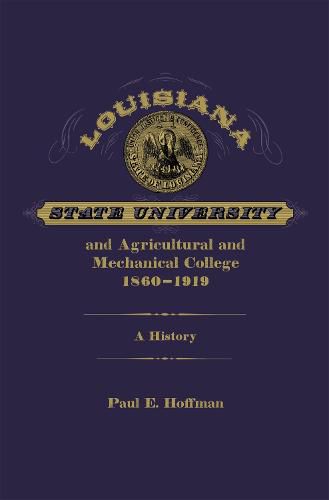Readings Newsletter
Become a Readings Member to make your shopping experience even easier.
Sign in or sign up for free!
You’re not far away from qualifying for FREE standard shipping within Australia
You’ve qualified for FREE standard shipping within Australia
The cart is loading…






Paul E. Hoffman’s Louisiana State University and Agricultural and Mechanical College, 1860- 1919 is a highly detailed analysis of LSU’s beginnings and early development, starting well before it first opened its doors in Pineville, Louisiana, in 1860. Hoffman reveals how political and ideological contests in areas of governance, curriculum, finances, discipline (the
military feature ), and student life influenced the early identity and development of the school, shaping and laying the groundwork for the university we recognize today.
The institution’s first name- the Louisiana State Seminary of Learning and Military Academy- reflected its contested character: part imitation of the Virginia Military, part true military academy, and part classical college. The school was renamed Louisiana State University in 1870 after graduating its first class. When the land-grant university created at New Orleans in 1874 merged with LSU in 1877, the school became Louisiana State University and Agricultural and Mechanical College. The new disagreements about the character of the institution did not resolve until 1919.
At the turn of the twentieth century, new challenges led to the establishment of a law school, the admittance of women for the first time, the organization of the institution into distinct colleges, and demands to emphasize on-campus agricultural instruction. Hoffman shows that President Thomas D. Boyd, faced with flat, inadequate state funding for the university as a whole, moderated those demands until 1918. Then the wartime emphasis on agricultural production, various federal programs that encouraged enrollment in LSU’s College of Agriculture, and a critical shortage of space on the downtown campus worked together to prompt the purchase of Gartness Plantation, the site of the current campus, but without any funds or immediate plans for its development.
Hoffman’s study ends in the spring of 1919. By then, the school had largely resumed its prewar rhythms in academic and extracurricular areas. The ROTC program, begun in 1917, was again in place, transforming LSU into the
Ole War Skule
of living memory. With most of its struggles over its identity resolved, LSU was poised to resume the growth that World War I had interrupted and that, with the development of the
new
campus, would characterize the school during the next twenty years of its history.
This first fully documented history of LSU in its early years contributes to a broader understanding of the growth of both LSU itself and American higher education, showing how fiscal realities and contested ideas about higher education during the post- Civil War era shaped university development.
$9.00 standard shipping within Australia
FREE standard shipping within Australia for orders over $100.00
Express & International shipping calculated at checkout
Paul E. Hoffman’s Louisiana State University and Agricultural and Mechanical College, 1860- 1919 is a highly detailed analysis of LSU’s beginnings and early development, starting well before it first opened its doors in Pineville, Louisiana, in 1860. Hoffman reveals how political and ideological contests in areas of governance, curriculum, finances, discipline (the
military feature ), and student life influenced the early identity and development of the school, shaping and laying the groundwork for the university we recognize today.
The institution’s first name- the Louisiana State Seminary of Learning and Military Academy- reflected its contested character: part imitation of the Virginia Military, part true military academy, and part classical college. The school was renamed Louisiana State University in 1870 after graduating its first class. When the land-grant university created at New Orleans in 1874 merged with LSU in 1877, the school became Louisiana State University and Agricultural and Mechanical College. The new disagreements about the character of the institution did not resolve until 1919.
At the turn of the twentieth century, new challenges led to the establishment of a law school, the admittance of women for the first time, the organization of the institution into distinct colleges, and demands to emphasize on-campus agricultural instruction. Hoffman shows that President Thomas D. Boyd, faced with flat, inadequate state funding for the university as a whole, moderated those demands until 1918. Then the wartime emphasis on agricultural production, various federal programs that encouraged enrollment in LSU’s College of Agriculture, and a critical shortage of space on the downtown campus worked together to prompt the purchase of Gartness Plantation, the site of the current campus, but without any funds or immediate plans for its development.
Hoffman’s study ends in the spring of 1919. By then, the school had largely resumed its prewar rhythms in academic and extracurricular areas. The ROTC program, begun in 1917, was again in place, transforming LSU into the
Ole War Skule
of living memory. With most of its struggles over its identity resolved, LSU was poised to resume the growth that World War I had interrupted and that, with the development of the
new
campus, would characterize the school during the next twenty years of its history.
This first fully documented history of LSU in its early years contributes to a broader understanding of the growth of both LSU itself and American higher education, showing how fiscal realities and contested ideas about higher education during the post- Civil War era shaped university development.